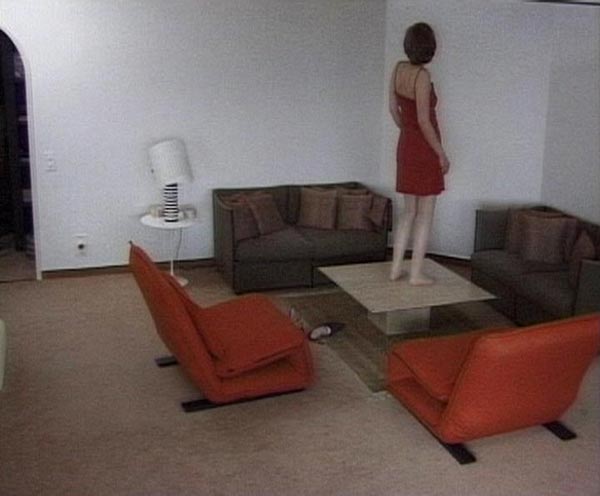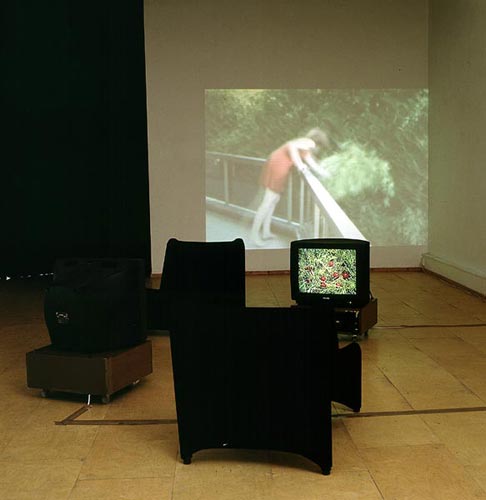Reflecting Home (1998)
Reflecting Parts (4 min)

Reflecting parts is a video based on two antagonistic construction systems: a narrative system, the temporal and linear development of an action, of a story, and the repetition of it. The story remains framed within the duration of its repetition and its passing off starts to be meaningful not only through its development, but also through its repetition. The beginning of the narrative becomes enlightened by the continual linear loop and involves an interference between the notion of reality and dream. We will never be able to know if the character is imagining the events alone, or the contrary.
Edited on the principle of a chain reaction, Reflecting parts proposes the creation of a memory, the artificial memory of the main character. This would erase itself instantly at the end of every loop or would function as a short circuit.
The memory becomes more artificial through the televisual aspect of the image (very flat, without any relief nor any shadow), which is supported by the presence of a stereotyped character. This is precisely the proposition of the work: to create and transform a personal/social memory based on standard and cliché images.
Reflecting parts is a portrait. It presents the psychological development of a “blood sister”, character shown in the “Training Lounge” installation. Therefore this character (a hollow and detached shape) finds its identity by becoming a projection. A mirror of one’s desire, that of the guests and the viewer.
Reflecting Home

Reflecting Home is an installation constituted by several videos projected and shown on monitors. All the video tapes are connected to each other in order to create a network, a memory approaching the question of desire (lack of desire), loneliness and dependence. Through a setting and a female figure, the work wavers between dreaming and waking, between attraction and repulsion.
This work confronts diverse layers of images and points of view:
- standardized images and “objective” points of view (close-ups of body parts and closed TV circuit of the space of inhabiting)
- narrative and subjective centrings of the female figure
Thus setting and character are reflected on each other. The various images influence themselves to rebuild a memory, that of the viewer as well as the filmed individual.
In this installation the elements are distributed in three units:
The first unit contains two video projections on two adjoining walls.
In the first projection one can see a woman dancing very slowly on a low table in a living room. From time to time she grabs the scarf around her neck and tightens it brusquely. This image is black and white as filmed by a surveillance camera. This quality of the image imposes a physical distance and paradoxically a proximity of the glance (that of the voyeur).
The second projection shows the same woman on a balcony, leaning against the handrail. She tries to catch and to stroke the branch of a bamboo tree. This image is in color, slightly blurred, edited in a series of zooms and dissolves.
In those two videos, the woman turns her back on the camera. One can’t see her face and she doesn’t seem aware of the presence of the camera. Those two tapes are then extremely phantasmatic. The projections on two walls function as mirrors or reflecting bay windows and enlarge the space around the viewer.
The second unit includes two sofas, two pieces of furniture for the monitors and two videotapes.
The sofas are placed in front of each other with the monitors on each side. This space is closed and comfortable as a living room, allowing the viewers to face each other.
The first video shows the close-up of a mouth endlessly breathing smoke in and out.
In the second tape one can see fingers placing and displacing red fruits in the grass.
This second group proposes on one hand a portrait, a redefinition of the character, on the other hand a mental space. The third unit is constituted by three monitors supported on the wall by metallic trays.
The monitors present diverse surveillance points of view of an empty flat.
The walls of the flat are white, without pictures, without memories of its inhabitants. The points of view change continuously, showing alternately the inside, the outside and the neighborhood of the habitation. Intermittently the black and white images are interrupted by very short sequences in color. Those flashes are close-ups of gestures performed by the character in the house.
This third part constitutes a representation, a condenser of the whole installation, the viewer playing the part of the guardian of a space and its memory.All the tapes are mute and work on an non-linear time-based system. The viewer is then able to confront to his surrounding and can project himself in it.




Installation view at Galerie Akinci, Amsterdam


Installation view at Cairo Youth Salon, Cairo


Installation view at Rijksakademie van Beeldende Kunsten, Amsterdam


































